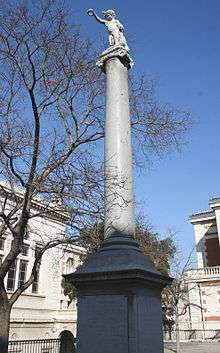Barthélémy-François Chardigny
| Barthélémy-François Chardigny | |
|---|---|
| Born |
September 4, 1757 Rouen, France |
| Died |
March 3, 1813 Paris, France |
| Occupation | Sculptor |
| Children | Pierre Joseph Chardigny |
Barthélémy-François Chardigny (1757-1813) was a French sculptor. He designed public sculptures in Marseille.
Early life
Barthélémy-François Chardigny was born on September 4, 1757 in Rouen, France.[1][2] He learned sculpture under Augustin Pajou.[2]
Career
Chardigny was a sculptor. He won the Prix de Rome in sculpture in 1782.[2]

Chardigny moved to Aix-en-Provence to design sculptures for the Palace of Justice in 1784.[2] He designed marble sculptures of King René and King Henry IV, a sculpture of the Greek mythology figure Venus, two fountains, a large sculpture with three figures, and another sculpture named Despotisme renversé.[2] However, they were removed during the French Revolution, and moved to the Ecole Centrale (then in Aix and later moved to Marseille) in 1802.[2]
Chardigny moved to Marseille, where he was commissioned a statue representing Liberty for the townhall in 1798.[2] He subsequently designed the same statue for many townhalls.[2] Meanwhile, he was commissioned other public sculptures by the city of Marseille.[2] For example, he designed the fountain on the Place des Capucines, then known as the place des fainéants; it was later dismantled and replaced with another fountain designed by Dominique Fossati, although the basin remains Chardigny's.[2] Meanwhile, Chardigny became a member of the Académie de Marseille in 1800.[1]
Chardigny moved to Paris in 1808, where he designed sculptures of Juno and Jupiter in the Louvre Palace.[2]
Personal life, death and legacy
Chardigny married and had a son, Pierre Joseph Chardigny, in 1794.[2] He died on March 3, 1813 in Paris.[1] Eight of his sculptures are in the permanent collection of the Musée des beaux-arts de Marseille,[3] while more sculptures are held at the Musée Granet in Aix-en-Provence.[4][5]
References
- 1 2 3 "Chardigny, Barthélemy François (1757-1813) forme internationale". Bibliothèque nationale de France. Retrieved December 2, 2016.
- 1 2 3 4 5 6 7 8 9 10 11 12 Parrocel, Étienne (1867). Annales de la peinture: discours et fragments. Marseille: En vent chez l'auteur. pp. 205–215. OCLC 222894854.
- ↑ "CHARDIGNY Barthélémy François". French Ministry of Culture. Retrieved December 4, 2016.
- ↑ Souvannavong, Kèoprasith (June 28, 2007). "Le nouveau visage du musée Granet". Radio France Internationale. Retrieved December 4, 2016.
- ↑ Draper, James David; Scherf, Guilhem (2003). Playing with Fire: European Terracotta Models, 1740-1840. New York: Metropolitan Museum of Art. p. 19. ISBN 9781588390998. OCLC 53459016.
| Wikimedia Commons has media related to Barthélémy-François Chardigny. |
